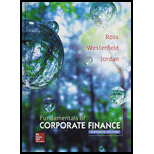
Dividends versus Reinvestment [LO2] After completing its capital spending for the year, Carlson Manufacturing has $1,000 extra cash. Carlson’s managers must choose between investing the cash in Treasury bonds that yield 3 percent or paying the cash out to investors who would invest in the bonds themselves.
a. If the corporate tax rate is 35 percent, what personal tax rate would make the investors equally willing to receive the dividend or to let Carlson invest the money?
b. Is the answer to (a) reasonable? Why or why not?
c. Suppose the only investment choice is a
a)
To determine: The personal tax rate.
Introduction:
C manufacturing company has 1000 extra cash. The managers decide to invest the cash in treasury bills that yield 3% or to pay the cash out to the investors.
Answer to Problem 16QP
Explanation of Solution
Given information:
The corporate tax rate is 35%.
Determine the personal tax rate:
Note: Consider the tax rate as ‘
Compute the individual after-tax dividend:
Therefore, the after-tax dividend can be invested in treasury bonds.
Compute the after-tax cash flow from treasury bonds:
Note: Let this be equation 1.
Compute the proceeds if the firm invests the money:
Compute the proceeds if the firm pays dividend:
Note: Let this be equation 2.
Whether the investors invest the after-tax dividend or receive the proceeds from the firm’s investment, the investors’ proceeds will be the same.
Solve these two equations to find the rate of indifference.
Therefore, the personal tax rate that makes the investors equally and fairly willing to obtain the dividend or C to invest money is 35%
b)
To discuss: Whether the above solution is reasonable or not.
Explanation of Solution
Yes, the above solution is reasonable.
Person C is indifferent if the after-tax proceeds from the $1,000 investments in the securities are identical. The above indifference occurs only when the tax rates are identical.
c)
To determine: The personal tax rate.
Answer to Problem 16QP
Explanation of Solution
Given information:
The preferred stocks yield at 6%, seventy percentage of income is exempted from the corporate taxes, and person C gets more benefits by investing in stocks.
Compute the personal tax rate:
The same answer in part (a) will apply to this, as the pretax returns are the same.
The seventy percentage of income is exempted from the corporate taxes and Person C gets more benefits by investing in stocks.
The rate of tax on income, which includes indifference, is lower.
Solve the equations to get the value of personal tax rate.
Derived equation: 1
Derived equation: 2
Note:
Corporate tax percentage is 35%
Find
Hence, the rate of personal tax is 10.50%.
d)
To discuss: The reason whether a low dividend payout ratio has a compelling argument or not
Explanation of Solution
Yes, the low dividend payout ratio has a compelling argument and it has some legal constraints, which restricts the firms from investing their money in the stocks of other companies.
Want to see more full solutions like this?
Chapter 17 Solutions
Fundamentals of Corporate Finance with Connect Access Card
- I need help with financial accounting questionarrow_forwardNeed help with the Correct answer of this Financial Accounting Questionarrow_forward: A project costs $100,000 and is expected to generate cash flows of $30,000 annually for 5 years. If the discount rate is 8%, should the project be accepted based on Net Present Value (NPV)?arrow_forward
- You are considering a project in Poland, which has an initial cost of 250,000PLN. The project is expected to return a one-time payment of 400,000PLN 5 years from now. The risk-free rate of return is 3% in Canada and 4% in Poland. The inflation rate is 2% in Canada and 5% in Poland. Currently, you can buy 375PLN for $100. How much will the payment 5 years from now be worth in dollars? Question 6 options: $1,576,515 $1,489,025 $101,490 $1,462,350 $142,060arrow_forward: A project costs $100,000 and is expected to generate cash flows of $30,000 annually for 5 years. If the discount rate is 8%, should the project be accepted based on Net Present Value (NPV)? i need hellarrow_forwardYou invest 60% of your money in Asset A (expected return = 8%, standard deviation = 12%) and 40% in Asset B (expected return = 5%, standard deviation = 8%). The correlation coefficient between the two assets is 0.3. What is the expected return and standard deviation of the portfolio? helparrow_forward
- Importers and exporters are key players in the foreign exchange market. Question 10 options: True Falsearrow_forwardTriangle arbitrage helps keep the currency market in equilibrium. Question 9 options: True Falsearrow_forwardThe use of dividends is a method by which a foreign subsidiary can remit cash to its parent company. Question 8 options: True False\arrow_forward
 EBK CONTEMPORARY FINANCIAL MANAGEMENTFinanceISBN:9781337514835Author:MOYERPublisher:CENGAGE LEARNING - CONSIGNMENT
EBK CONTEMPORARY FINANCIAL MANAGEMENTFinanceISBN:9781337514835Author:MOYERPublisher:CENGAGE LEARNING - CONSIGNMENT Intermediate Financial Management (MindTap Course...FinanceISBN:9781337395083Author:Eugene F. Brigham, Phillip R. DavesPublisher:Cengage Learning
Intermediate Financial Management (MindTap Course...FinanceISBN:9781337395083Author:Eugene F. Brigham, Phillip R. DavesPublisher:Cengage Learning




